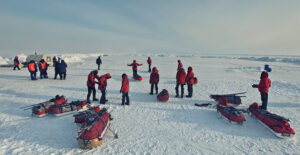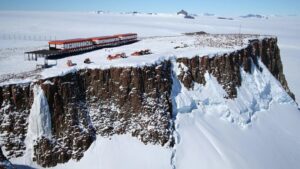Although I’ve done many expeditions to both the North and South Poles, both as an independent traveler and a guide, every fresh trip brings up new gear ideas. There are also old, tried-and-true standards that I have used for years. As I begin the South Pole season, let’s take a look at my gear. Today: Parka ruffs.
One note: Proper gear is just one aspect of polar travel. Developing skills, planning and logistics, understanding the polar environment, and knowing how to minimize risk are all equally important. If you would like to fast-track your development as a polar traveler, consider hiring an IPGA guide.
Parka ruffs
A fur ruff is an essential item that has been used for generations by indigenous northern people to protect their faces against cold and wind.
Many assume that a ruff is just a fashion accessory worn by modern adventurers to complete the explorer look. Equally, many polar travelers don’t quite get it right. Their ruffs are too short, poorly placed, or made from the wrong type of fur.
But as anyone who has skied for weeks into a headwind on the Antarctic plateau knows, even the best ruff by itself isn’t enough. It needs to be matched with a suitable hat, mask, neck gaiter, and eyewear. Having an excellent ruff just gives you more options.

A traditional sunburst ruff.
Sunburst ruffs
Originally made from caribou fur (later coyote, wolf, husky, wolverine, and even beaver), the ruff was part of a full-body fur ensemble. The most efficient style of ruff was the sunburst configuration, where the ruff completely encircles the face.
Early polar explorers adopted this traditional clothing system but found it too warm for active work such as sled hauling. Slowly, more modern fabrics and designs better expelled excess heat and moisture. But the ruff remained, now attached to the rim of a modern shell jacket hood. It is still a key component in facial protection for polar adventurers.
The science (and associated low-speed wind tunnel data) behind ruffs is complex but distills down to minimizing the disturbance of a boundary layer of warm air next to the face.

A wolf/wolverine combination ruff. Photo: Eric Philips
A ruff shouldn’t obscure vision
Traditionally, polar inhabitants wore baggy anoraks with loose hoods. This allowed heat from the body to rise into the hood and move outward, creating a warm layer against the face. The ruff, in particular the starburst geometry, encircled the face but sat behind the cheekbones for better side vision for hunting. It also minimized frost buildup. The pocket of stagnant, warm air over the face mitigates frostbite in winds from any angle. Because of zippered fronts on our jackets, modern ruffs are worn more openly and we lose the sunburst effect. But ruffs can still provide an excellent defense.
Fur with stiff guard hairs (the long ones that break up the wind) and dense matting underneath is preferable. One of the biggest considerations is the irregularity of the fur. A rough halo of fur creates frictional forces that slow the air moving onto the face, minimizing heat transfer. Wolverine remains the best fur for extreme cold because ice from breath doesn’t stick to it. It just brushes off as loose powder. Wolverine fur is often paired with wolf.
A typically prepared ruff is around 7-10cm (3-4 inches) wide with a length of around 65-75cm (26-30 inches) depending on preference. But if you want to create a ruff that can encircle your face, then longer is better.

A short wolf ruff on the Ronne Ice Shelf, Antarctica, December 2007. Photo: Eric Philips
Attaching a ruff
There are a number of ways to attach a ruff to your hood. The most secure method is hand sewing, but velcro, a zipper, press studs, or even magnets, make ruffs interchangeable. Except for sewing, these require reciprocal connectors on the hood.
First, be sure to orient the ruff correctly. When holding it horizontally, the middle peak of guard hairs should point upward. Otherwise, it will obscure your vision. I prefer to wrap the ruff equally around the rim of the hood, half inside and half outside. To attach, fold the ruff in half and mark the center, do likewise with your hood, and then start sewing from the middle, down one side, and then the other. I use broad stitches of strong polyester thread.
Continue all the way to the end of the hood where it meets the zipper of your collar. Let any surplus ruff hang over the edge, as these bits will close the circle when you zip up. Trim to a point as required.

Eric Philips, second from left, and clients at the South Pole, January 2018. Photo: Eric Philips
Synthetic ruff?
Once attached, you will need hood adjustment options to position the height of the ruff, or it may hang over your eyes. Ruffs can be quite heavy. All my hoods are fitted with an old-fashioned tilt adjuster.
I have tried a synthetic ruff and it was next to useless. We are not quite there with faux fur, just as we are not quite there with synthetic down. Sustainability of and trade in fur are issues you should be acutely aware of. How was the animal killed and harvested? Perform your due diligence to find out exactly what type of animal your ruff comes from. Is the animal endangered or threatened? Trappers in North America can still sell wolverine pelts, although it is a threatened species.
Finally, be sure that the fur comes with a certificate of origin. Freighting or traveling internationally with any animal product is complex and can lead to confiscation at international borders. Consult the laws of the country of origin, your own country, and any country you travel to. Always travel with your paperwork. The best place to start your research is the Convention on International Trade in Endangered Species, or CITES.






